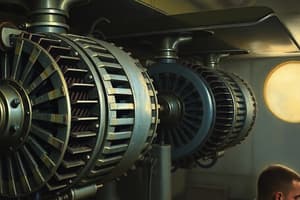Podcast
Questions and Answers
If an armature has three windings, it will produce a single current wave.
If an armature has three windings, it will produce a single current wave.
False (B)
The three-phase alternator is typically used for the distribution of electric power.
The three-phase alternator is typically used for the distribution of electric power.
False (B)
Voltages as low as 13,200 are common in alternators.
Voltages as low as 13,200 are common in alternators.
False (B)
Two-phase alternating current is produced by three windings set at right angles to each other.
Two-phase alternating current is produced by three windings set at right angles to each other.
Three-phase alternating current is the most commonly used type of current in modern electrical-engineering practice.
Three-phase alternating current is the most commonly used type of current in modern electrical-engineering practice.
An AC generator can produce direct current without an external DC source.
An AC generator can produce direct current without an external DC source.
The frequency of the current delivered by an AC generator is equal to the number of poles and the number of revolutions per second of the armature.
The frequency of the current delivered by an AC generator is equal to the number of poles and the number of revolutions per second of the armature.
Low-speed AC generators are built with as few as 2 poles.
Low-speed AC generators are built with as few as 2 poles.
Alternators driven by high-speed turbines are often built with a large number of poles.
Alternators driven by high-speed turbines are often built with a large number of poles.
The current generated by an alternator is known as direct current.
The current generated by an alternator is known as direct current.
Flashcards are hidden until you start studying
Study Notes
AC Generator Basics
- A simple generator without a commutator produces an alternating current (AC) that changes direction as the armature revolves.
AC Generator vs DC Generator
- AC generators differ from DC generators in two main aspects:
- Armature winding ends are connected to solid unsegmented slip rings on the generator shaft instead of commutators.
- Field coils are energized by an external DC source rather than by the generator itself.
AC Generator Design
- Low-speed AC generators can have up to 100 poles to improve efficiency and achieve desired frequency.
- High-speed AC generators (alternators) driven by turbines are often two-pole machines.
Frequency of AC Generator
- The frequency of the current delivered by an AC generator is equal to half the product of the number of poles and the number of revolutions per second of the armature.
Alternator Construction
- Alternators are constructed with a stationary armature and a rotating rotor composed of field magnets.
- The principle of operation is the same as that of an AC generator, but with the magnetic field in motion instead of the conductors.
Single-Phase Alternating Current
- The current generated by an alternator rises to a peak, sinks to zero, drops to a negative peak, and rises again to zero a number of times each second, depending on the frequency.
Multi-Phase Alternating Current
- If the armature has two windings at right angles, two current waves are produced, forming two-phase alternating current.
- If the armature has three windings at 120° to each other, a triple wave is produced, forming three-phase alternating current.
- Three-phase alternating current is the most commonly used in modern electrical engineering.
Voltage and Applications
- Voltages as high as 13,200 are common in alternators.
- Three-phase alternators are typically used for generating electric power.
Studying That Suits You
Use AI to generate personalized quizzes and flashcards to suit your learning preferences.




